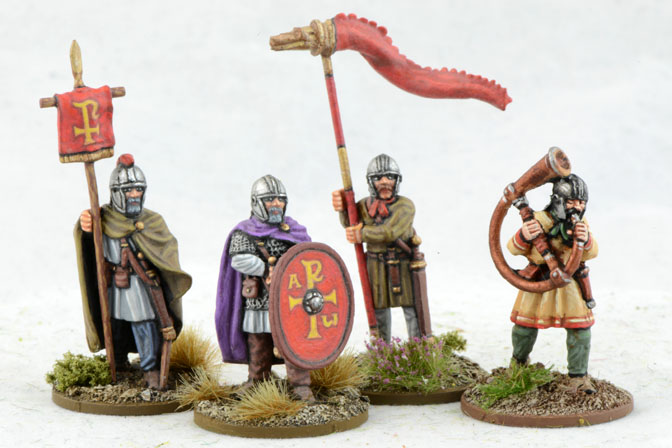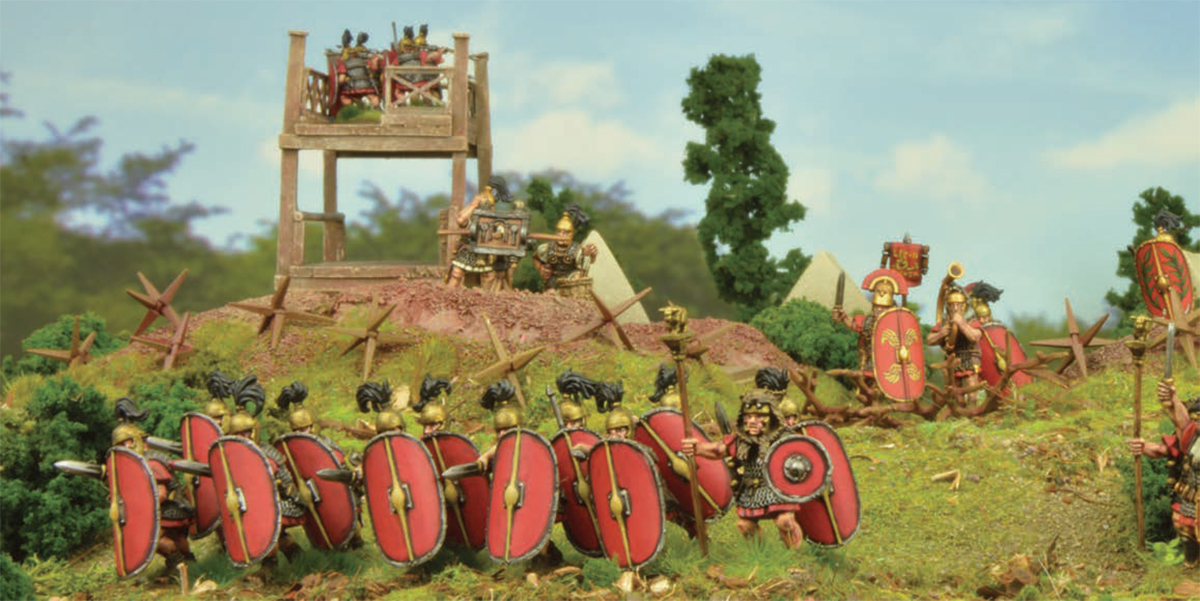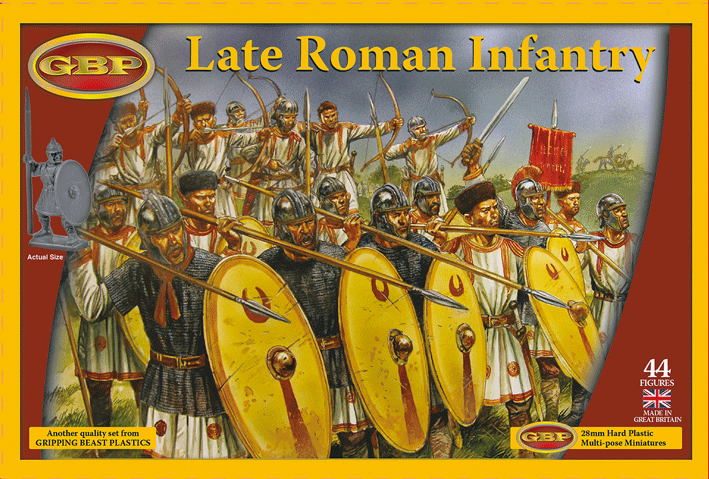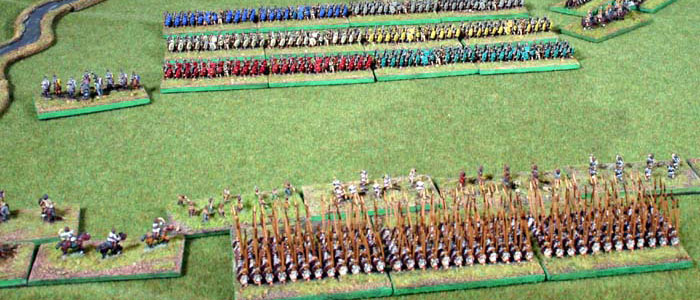Goonhammer Historicals is our new series, looking at the incredibly diverse world of historical wargaming – different scales, different eras, different rulesets. Today in Goonhammer Historicals we look at getting started with gaming in Ancient Rome, from the Punic Wars through to the fall of the empire in the west.
As one of the most popular periods in historical wargaming there’s a huge range of options in playing in the era. You have large battles using games like Hail Caesar, which represent enormous armies clashing on the field, all the way down to gang scuffles in the streets of Rome itself in Gangs of Rome. Whatever model scale or count you want to play you’ll be able to find a game and model range to support it.
In terms of the eras within this period, you’ll find that Late Republican and Early Imperial are the most popular (50BC – 50AD roughly). However there is also support for earlier Republican forces with the Punic Wars being a favourite subject, and some for the later Imperial period as the Western Empire declined in power.
Historical highlights
Over five hundred years until 200 CE, the city-state of Rome expanded from being a Republican territorial power to reaching its Imperial zenith under Emperor Trajan. In the 375 years between the First Punic War and the Fall of the Western Roman Empire in 111 CE, Rome fought a number of wars that saw it solidify its control of much of the world it came into contact with. Historical wargaming lets you wage wars set in some of the most fascinating periods of Roman history. Here’s a quick tour of the most interesting and impactful wars Rome fought that you can recreate on the table.
The Punic Wars

Between 264 and 146 BCE, the Roman Republic and the City-State of Carthage fought three wars that eventually led to the Roman control of the Mediterranean. As the Roman Republic began to expand, it was inevitable it would come into conflict with the Carthaginians. Most gaming opportunities in the Punic wars will focus on the Second Punic War.
The Second Punic War (218-201 BCE) is the most famous of the Punic Wars, and the man responsible for it was perhaps one of the greatest generals of all time, Hannibal Barca. Hannibal was a master tactician and in one of his most famous moves he avoided taking combat losses during a landing by crossing his army, including 37 war elephants, over the Alps into Gaul, descending into Roman territory from the north. The Second Punic War went on for 17 years and saw many battles that were early victories for the Carthaginians, including the famous battle of Cannae in which Hannibal completely destroyed a Roman force led by two Roman Consuls.
Despite being able to march up and down Italy with relative impunity, Hannibal was eventually forced to return to Carthage with his forces after the Romans had reconquered Iberia. Following this, the Romans, under the command of Scipio Africanus Major, invaded North Africa once again and this time resoundingly beat the Carthaginians at the Battle of Zama. This loss led to the destruction of Carthaginian power in the region and they were forced to pay a massive war indemnity.
On the tabletop this is the classic Early Republican period, with a focus on the manipular system of the Romans, and the varied mercenary forces of Carthage. These dramatically different armies give a real variety and distinct flavour to each of the major forces in this war.
Roman-Gallic Wars

Wars between Rome and its northern neighbour Gaul occurred for as long as both existed. The most famous of these wars occurred between 58 – 50 BCE, when Julius Caesar led his badly outnumbered forces in a series of campaigns that were so successful that his growing popularity led to the formation of the Empire.
Gaul at the time was a loose collection of tribes that warred with one another as much they did outsiders. When Caesar began his war with the Gauls, he approached each of the major tribes individually, fighting the Helvetii, the Suebi and the Belgae in succession. Eventually, Caesar’s conquests in the region would also see him clash arms against the Germanic and Britannic tribes as well.
At the conclusion of the wars, the remaining Gallic tribes would band together as a massive army under the command of Vercingetorix, the chief of the Arverni tribe. At the Battle of Alesia, the Romans laid siege to the fortified hill settlement of Alesia. When Vercingetorix heard of the siege, he rallied remaining tribesmen to him in an effort to destroy the Romans. Caesar decided to build a second fortification around his siege force, mostly encircling Alesia. When the Gallic relief force arrived, they attacked the encampment from the outside while the besieged Gauls attacked from the inside. The Romans managed to fight off both during a few days of bitter fighting, eventually driving off the Gauls. Vercingetorix then gave himself up in an effort to save his people from annihilation. Alesia was the last major battle in Gallic subjugation and it saw the destruction of Gallic power in the region and its annexation as a Roman province.
Of all wars of the Roman age, this is the most iconic. Caesar’s legions are more uniform than those of the earlier Republic, and his tactical brilliance is still studied today. The Gauls, Britons and Germans make for a fascinating diversity of enemies, and there are plentiful miniatures and rule sets to support wars against them.
Boudica’s Uprising

A cultural touchstone 2000 years later for those of us brought up in England, the revolt of the Iceni tribe against the Roman occupying forces in 60 CE was short-lived but bloody. Let by their Queen Boudica, the Iceni and their tribal allies ravaged Camulodunum (modern Colchester) and burned the city to the ground. The Roman governor, who had been campaigning in Wales, hurried back to Londinium (London) to defend it, but was so outnumbered he was forced to abandon it, and the city of Verulamium (near the modern St Albans). The tribes burned the cities and slaughtered the Romans in them, killing tens of thousands in a few days, many by torture. Finally Boudica was defeated in battle by a heavily outnumbered Governor Suetonius, but the Emperor Nero was reportedly close to abandoning the island altogether before this stunning victory.
On the table this is the classic Roman-British clash for many people in the UK. The chariots of Boudica ridden by her noble warriors are an iconic image, and the tribe’s victories cannot be underestimated. The details of their dramatic defeat are unclear, and so it’s a perfect opportunity for players to recreate this slice of history and see which way things go in a recreation.
Trajan’s Dacian Wars

As Trajan pushed the Empire to its further extent, the vast complex economy he had created began to stall, and one of the most pressing issues were on his eastern borders in Moesia. The Empire could now only sustain itself on conquest, and the Dacians to the north of the province had been a thorn in the Romans’ side, having beaten the Romans and sacked Moesia in 88 CE. Now, 15 years later, Trajan recommenced hostilities, eventually besieging the Dacian capital and forcing terms. In 105 CE, the Dacians having rebuilt their forces, raised the Roman garrisons and once more Trajan defeated the Dacians in detail, before launching an invasion of Parthia to the east.
On the table this battle is fascinating for wargamers because of the unusual equipment and tactics of the Dacians. Their most vital weapon was the Falx,a vicious sickle-polearm hybrid that tore through Roman shields and armour like butter. This allowed them to seriously threaten the dense formations of the Romans like few other forces could, and their brutal charges and clever use of cavalry and skirmishers made this a brutal and bloody war.
What games should I play?
Here are a few of the most popular rule sets for playing wargames in Ancient Rome. There are dozens if not hundreds of other games available, but these are some of the most accessible, well-known and popular of them. If you’re new to historicals, is’s worth remembering that you can normally us your models across a variety of different games, and many of them either implicitly or explicitly will even let you adapt to different scales – so a set of rules written for 28mm might have a conversion for 6mm, or so on. If you see a set of rules that you’re excited about and you already have an army or two for the period, then the only thing standing between you and playing a game is your ability to persuade your friends!
Hail Caesar by Warlord Games

First published in 2011 and designed by industry veteran Ricky Priestley, Hail Caesar is a close spiritual successor of Warmaster Ancients. It preserves much of what made that game great, with a focus on the uncertainty of command and the struggle of wielding huge armies effectively, but with many of the rough edges sanded down.
The game focuses on large scale battles, featuring dozens of units and potentially hundreds of models on each side. This can make it an intimidating project for a new hobbyist, but there are great rules in the book for scaling down model sizes. The Goonhammer Historicals team have had great fun with this at 6mm scale, which best represents the huge sweep of battle.
You can grab the rules for Hail Caesar from Warlord Games.
SPQR by Warlord Games
A companion product to Hail Caesar, focused on smaller clashes in the ancient world. These skirmish focused rules are best with 30-50 28mm miniatures a side, and feature comprehensive campaign rules. There’s some debate among the community as to how good these rules actually are, but a broad consensus that the FAQ update that overhauls some key areas of the game dramatically improved it.
You can get a copy of the SPQR rules from Warlord Games.
Infamy Infamy by Too Fat Lardies
A recent release by a firm Goonhammer Historicals favourite, Infamy Infamy is the Lardies’ take on late Republican and early Imperial Roman clashes with the “barbarian” forces of northern Europe. There are planned supplements for the Punic Wars and conflicts further east, but for now the faction choice is very specific to European wars of that period.
Intended for play with 40-70 miniatures a side, it’s written with 28mm miniatures in mind but is flexible enough to be played at almost any scale. It’s very intentionally representing small skirmishes and raids, and has a big focus on the asymmetric warfare common to the time.
You can get a copy of Infamy Infamy from the TFL website, and we’ll be diving into the game in a detailed review next week.
Gangs of Rome by Footsore Miniatures

The smallest scope for a game in our list, Gangs of Rome is about thugs and criminals battling it out in the ancient metropolis. It’s a very unique game, and has lots of interesting custom mechanics to really drive home the bloody desperation of the combatants. It’s also an amazing excuse to build some truly astonishing tables, thick with Roman architecture. Because of its unusual subject matter you really are best off getting hold of the official miniatures range, which are 28mm scale metal.
You can get a copy of Gangs of Rome from Footsore’s website.
What miniatures should I buy?
There are dozens of manufacturers of Roman miniatures, and of their enemies, so we just run down a handful here. We focus on hard plastic suppliers, as these are the easiest for new players to work with.
Victrix Games

Victrix are a manufacturer who focus on 28mm hard plastic historical miniatures, and their Ancient Rome ranges are some of their most extensive. They have full hard plastic ranges for Republican and Early Imperial Romans, including novelties like war elephants; an extensive Ancient Gaul range; a strong selection of kits for Carthage; a very comprehensive Greek range; and a wide selection of kits for other factions such as Germans, Dacians, Samnites, Numidians, and so on.
Victrix kits are multipart multipolar hard plastic, and while the quality varies somewhat depending on the age of the kit, they are uniformly high, and comparable at their worst to many kits from other manufacturers. The Goonhammer Historicals team tends to view Victrix kits as the gold standard for historical hard plastic miniatures, and the ancient ranges are no exception.
You can find all of Victrix’s ranges on their website.
Warlord Games

There is simply no other company offering such an extensive range for 28mm historical miniatures as Warlord Games, and their Ancient Rome ranges are no exception. They have plentiful hard plastic kits and metal and resin miniatures to make up the gaps. The quality can vary more, a result of them having formed their ranges by buying up other manufacturers in part, but it’s hard to fault the extent of options. Their metal and resin castings tend to actually be more reliable in terms of quality than their plastics, if you’re comfortable working with those materials, so many hobbyists supplement ranges from elsewhere with characters and unusual units from Warlord.
You can find Warlord’s extensive ranges on their website.
Agema Miniatures

One of the smaller manufacturers working in hard plastic, Agema are notable because they are one of a small number of places to focus on Republican Rome, especially the Punic Wars. You’ll find good quality 28mm hard plastic Legionaries and Velites, as well as their counterparts in the Carthaginian forces. These are supplemented with metal miniatures filling out these ranges.
You can buy Agema Miniatures on their website.
Gripping Beast

A valuable source of Late Imperial Romans, you can find hard plastic kits for 28mm Late Roman infantry; and light, heavy and cataphract cavalry. You’ll also find kits for the Goths, which can help with the sparse representation of this faction in plastic. In metal the Gripping Beast ranges are truly extensive, and there are plentiful options to round out a force.
You can buy Gripping Beast miniatures from their website.
Baccus 6mm

One of the best dedicated 6mm suppliers of historical miniatures, Baccus work in metal and supply a vast range of products. Their Roman ranges cover the whole spread from the early Italic kingdoms through to the late Roman Empire, and features almost every major enemy of Rome. It’s truly impressively extensive.
The casting is good, and the miniatures have a really surprising amount of detail for their scale. It can take some getting used to if you’ve not worked with 6mm miniatures before, but if you’ve not dipped your toe in this is a great place to start.
You can order Baccus 6mm miniatures from their website.
Plastic Soldier Company
A newcomer to ancients, PSC are now offering some late Empire Romans and enemies for them in 15mm. They advertise these as “Ultracast” which appears to be a kind of flexible plastic. Reviews are mostly positive, and a second range of ancients is due later this year. As there are effectively no other plastic options for 15mm Romans, they’re worth a look.
You can get hold of the range from the Plastic Soldier Company website.
Where to start
There are a huge number of routes into gaming in the ancient Roman world, and the choice can be overwhelming. That’s why we’ve put together two recommended starting bundles here. Both of these give you two full forces – enough to genuinely play the game in full.
Infamy Infamy Starter (£173)
- Infamy Infamy basic bundle (£34)
- Warlord Early Imperial Roman Veterans (£18)
- Warlord Early Imperial Roman Veterans (£18)
- Warlord Early Imperial Roman Auxiliaries (£20)
- Warlord Early Imperial Romans: Western Auxiliary Archers Contubernium (£12)
- Warlord Celtic Warriors (£22)
- Warlord Celtic Warriors (£22)
- Ancient Celts: chieftains pack (£5)
- Ancient Celts: slingers (£12)
This first starter gives you everything you need to play Infamy Infamy using two of the standard forces.
The Roman force is made up of four units of 8 legionaries, one auxiliary unit and one unit of auxiliary archers. You’ll have enough auxiliaries to reinforce with support options, but you might want to consider picking up some auxiliary cavalry at some point. I’ve picked the Veterans over the standard Legionary kits because they’re a little cheaper (they don’t include a war machine useless to this game) and also have some more characterful poses. They also have good bits to use your spare bodies to build a centurion and an optio or two (who act as your commanders on the ground).
The Gaul force is infantry heavy, with five units of 10 warriors of various quality and a small group of skirmishing slingers. You won’t have much spare here, so probably best to choose support options around ambush points and extra leaders. If you wanted to expand your choices, picking up some more skirmishers (maybe with javelins) wouldn’t go amiss, or some Gallic cavalry could be a good addition.
6mm Hail Caesar Starter (£145.30)
- Hail Caesar Rulebook PDF (£20)
- Baccus 6mm Hail Caesar Early Republican Roman Army Pack (£57.50)
- Baccus 6mm Hail Caesar Carthaginian Army Pack (£67.80)
This starter gets you up and running with some impressive armies to depict battles in the Punic Wars. These army packs are just under 500 points in total making them substantial forces. Baccus minis don’t come with bases so you’ll need to get hold of some separately – I’d recommend a mix of 20mm x 20mm and 40mm x 20mm bases to give you the most flexibility.
On the Republican side you have the classic three lines of triarii, hastatii and principes making up the bulk of the army. This is an incredibly strong and flexible battleline, ably supported by Italic allies or various stripes and some Numidian cavalry. This army is all about mastering the use of that legion core, the three types of Roman soldier that were essential to their success.
For the Carthaginians there is a small core of Libyan soldiers, but ultimately their strength is in the variety of their many mercenaries and tribute soldiers. There are 14 different types of troop in this army, and using them all correctly is the main challenge. Master that and you’ll have an enormously effective toolkit at your disposal that can run rings around the enemy. Fail, and the strong Roman core will overwhelm you.
Wrap-up
That’s it for Getting Started: Ancient Rome. We hope this has been a helpful guide to how to get into this exciting period of historical wargaming! Over the next few weeks, we’ll have more tiny Roman content, including a How to Paint Everything guide, a review of Infamy! Infamy!, and some terrain building tips for getting your table to look appropriately Roman. If you have any comments or feedback, then let us know in the comments here, on Facebook, or at contact@goonhammer.com.


